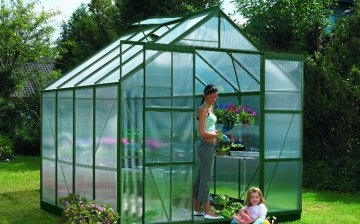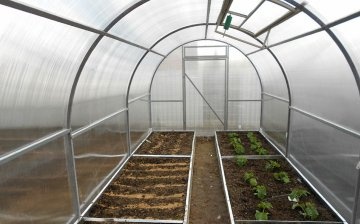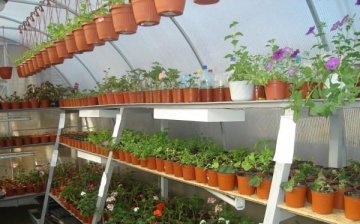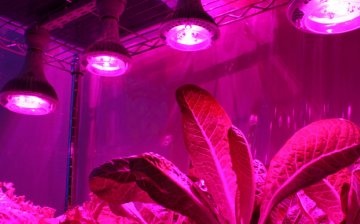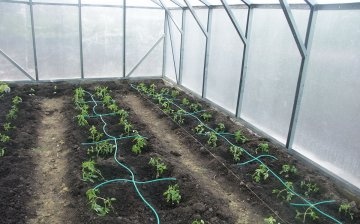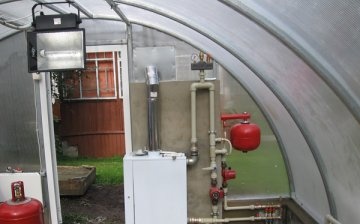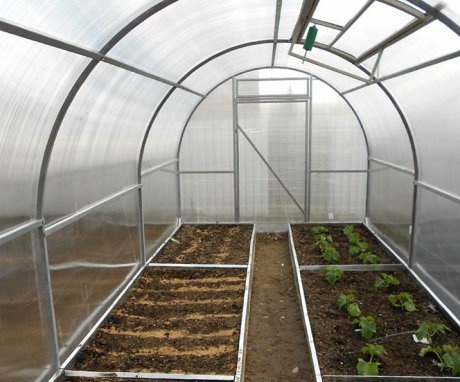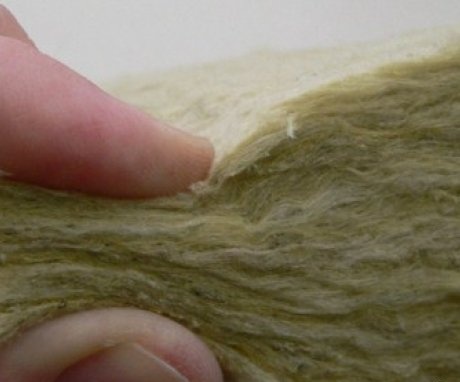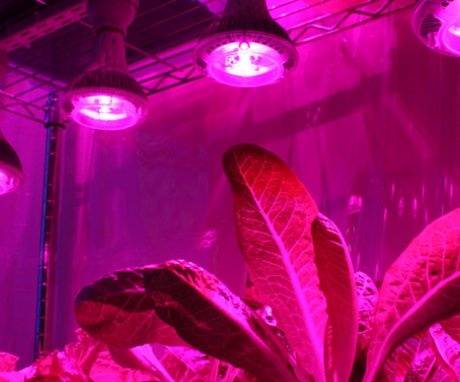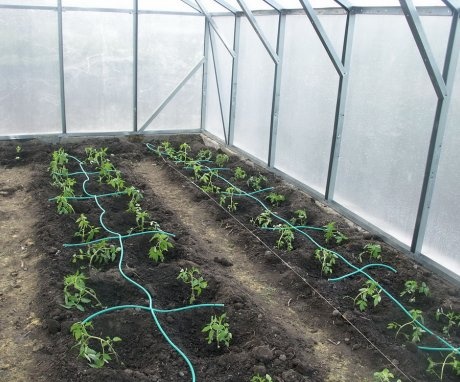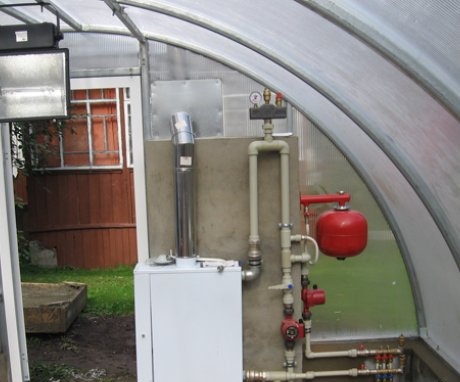Basic recommendations for arranging a greenhouse inside
The greenhouse on the garden plot has become an integral structure. Thanks to her, the gardener manages to grow an early harvest, despite the vagaries of the weather. Now more and more often they began to build year-round greenhouses. Fresh cucumbers, radish and greens all year round is the dream of every vegetable grower.
The question of arranging a room for plants arises whenever it is planned to grow vegetables or flowers for sale. It is very important to properly organize the internal space in order to get a bountiful harvest. Otherwise, all work will go down the drain.
Content:
- Preparing the soil and planning the beds
- Unconventional greenhouse substrates
- When are racks used?
- Arrangement of artificial lighting
- Organization of watering
- Organization of the heating system
Preparing the soil and planning the beds
A greenhouse is a closed room in which a special microclimate is formed. There is always high humidity and air temperature in the room. In accordance with this feature, the soil is prepared.
The main requirement is the absence of viruses and microbes in the substrate.
This can be achieved by cultivating the land with a weak solution of potassium permanganate a couple of months before planting. You can also use special chemicals, but most gardeners refuse them.
Preparation rules:
- The soil mixture is prepared in advance. As a rule, they mix ordinary garden soil with the addition of humus, compost and mineral fertilizers... The soil should be loose, air and moisture permeable. Heavy substrates are diluted with coarse sand, which is also disinfected. Vermiculite can be added instead of sand. The bottom of the trenches, where the earth will be filled up, is covered with a drainage layer - broken brick or expanded clay. The soil must be enriched with all nutrients, since it is laid for several years - four years. Changing the soil every year is costly and time-consuming. Therefore, it is worth taking care of the land so that the change of the top layer is sufficient for the subsequent growing of plants.
- The beds and their orientation are planned in advance. By all the rules, they are oriented from north to south. Depending on the total area of the greenhouse, the gardener calculates the number of beds. Do not forget that you will need to walk around them. Therefore, the planning of the paths goes hand in hand with the organization of the beds. The optimal size of the beds in width is 80-90 cm, the width of the paths is 70 cm. Gardeners came to these sizes experimentally. It is convenient to work with the beds, you can walk along the paths with a watering can, a bucket or a cart without touching the plants. The paths must be covered with boards or other material, for example, rubber. As an economy material, gravel, sand or crushed stone is suitable. They fill up the space between the beds.
- Before filling the prepared substrate, organize the boxes. Use planks or beams to build the structure around the perimeter so that the earth does not crumble. Wooden elements must be treated with antiseptics and covered with paint or varnish, otherwise they will quickly fail.Instead of boards, you can use slate or plastic structures. Do not forget that the box must be strong. The height of the rails may vary. It all depends on the wishes of the gardener, on how it is more convenient for him to work. Usually the height of the box is raised to 50-60 cm. It is more convenient for someone to work with high ridges up to one meter in height. In this case, much more land will be needed.
It is better to organize the beds and cover the soil in the fall. During the winter, the soil will shrink a little and undergo natural disinfection in the cold. In the spring, you usually have to fill up the soil and start planting later.
Unconventional greenhouse substrates
Advanced gardeners often resort to using alternative substrates - peat, mineral wool, expanded clay. Arrangement of a greenhouse using such materials requires special conditions. Growing vegetables or flowers on rockwool is essentially hydroponics. The substrate is fed with special solutions enriched with all the necessary substances. In the case of using an unusual substrate, land is not required.
High racks are built indoors, on which they will be located hydroponic plants and cassettes with plants.
The main condition for such structures is sterility. Their organization will have to cost a lot, but as a result, the return will be much higher than the costs.
Many gardeners combine the use of ordinary land with unconventional materials. For example, seedlings grown in mineral wool on racks, then transplanted into standard beds with soil. Many people add expanded clay or vermiculite to the soil to make it friable.
Agronomists do not recommend using one room for hydroponics and for growing plants in the ground. The explanation is simple - when a fungus or a virus appears in the ground, the disease will necessarily spread to the department with hydroponics. Growing plants without the use of land is so popular that it excludes the possibility of the appearance of fungi, viruses and bacteria. Therefore, mixing traditional cultivation with hydroponics is impractical.
When are racks used?
If a greenhouse is being built for the purpose of growing flowers, strawberry or other low-growing plants, it is more expedient to organize racks in several tiers instead of beds. The material used is wood, metal or durable plastic. It is very important to correctly calculate the width of the shelving. The sizes, as a rule, coincide with the sizes of the beds - 80-90 cm, the length varies depending on the total area of the greenhouse and the wishes of the gardener. Long structures are reinforced with additional vertical beams for strength and stability.
Remember that the racks must be able to support a lot of weight.
If the greenhouse is large, you can divide its area into two sections - one for shelving, and the other for tall plants, with beds. Thus, the gardener will be able to grow many crops in one room. With this planning, crop compatibility will be an important consideration. This is taken into account without fail.
When purchasing a polycarbonate greenhouse, racks and boxes for beds often come with it. It is convenient, you do not have to waste time building structures. You can find a greenhouse that comes with all the additional material.
Arrangement of artificial lighting
The greenhouse, which is planned to be used all year round, needs lighting. Plants are unlikely to produce crops and develop normally without backlighting. In winter, daylight hours become shorter, as a result, crops do not have enough of it. Replenishment of losses is possible only with the help of additional lighting... Conventional lamps are not suitable for this. It is necessary to select special lighting equipment.
When supplying electricity to the greenhouse, keep in mind the fact that the room will always be humid.
All connections and cables should be carefully insulated and crimped. Usually the main cable leads to the greenhouse in a hinged way. The underground wiring method has not worked well. Experienced gardeners recommend making grounding. Fire safety when conducting electricity should be in the first place. Consider installing a shield inside the greenhouse, and a switch should also be provided. With its help, if necessary, you can quickly de-energize the room. If you do not understand the intricacies of electrical wiring, contact a specialist.
The choice of special lamps occupies one of the leading places in the organization of lighting in general. Since we are talking about a large lighting area, lighting equipment should be selected according to this condition. For greenhouses, greenhouses and conservatories, it is recommended to install gas-discharge lamps - metal halide and sodium. The former have the following advantages:
- The lamps are powerful and capable of illuminating large areas.
- They emit the entire spectrum necessary for plants (red, orange, blue and violet).
- Economical.
- They can be used for germinating seeds, and for growing already mature plants.
Sodium lamps are installed if a special compartment in the greenhouse is provided for growing seedlings from seeds. Sodium equipment emits orange and red spectrum - it is he who stimulates seed pecking and sprout development. The installation of metal halide and sodium lamps is considered the ideal solution for greenhouse lighting.
Instead of gas-discharge lamps, ordinary fluorescent lamps are often installed. They are also suitable for greenhouses, but it should be borne in mind that they are not powerful enough and a rather large number of lamps will be required. Also keep in mind that for tall plants, more than one meter, a fluorescent lamp will not be enough. In this case, it is more expedient to opt for metal halide equipment.
Don't forget about simple installation rules backlight... Lamps are installed on special, adjustable fittings strictly above the plants at a distance of 30-40 cm. If racks are installed in the greenhouse, then lighting is supplied under each rack so that each plant receives its own portion of light. If you plan to wire the lighting above each rack, then it is wiser to make the structures themselves from metal or special plastic. As a result, no fire will occur in the event of a short circuit.
Organization of watering
Watering in a small greenhouse, it usually does not present any difficulties. Gardeners use the good old way - watering with rainwater with a watering can. However, experienced growers say that the water should not get on the leaves and stems, which is inevitable when watering by hand. Large greenhouses are often physically impossible to water manually. Therefore, it is worth planning an irrigation system in order to facilitate your work.
There are several ways to deliver water to the plant:
- Drip irrigation... This method has worked well. It involves the installation of a simple system consisting of pipes, a container of water, droppers, a pump, a well or a well. Many gardeners make the entire system on their own without purchasing equipment from the store. In fact, water is supplied to the plant from small-diameter pipes through droppers. The pipes run along the soil along the rows of plants. As a result, the soil is gradually saturated with moisture, the leaves and stems remain dry. This system can be automated with additional sensors and a control system. You can buy ready-made equipment that is not that expensive.
- Subsoil method. It is also used, but less frequently. Determining how much water is needed for a particular crop is difficult. Therefore, plants are often left without moisture.Moreover, you need to know at what depth to lay containers with water, for each type of plant it will be different. In this regard, subsurface irrigation is problematic. The system works in much the same way as drip irrigation. Only pipes or water tanks are buried underground.
- Automatic irrigation of plants - is an expensive business and is intended mainly for greenhouses with large premises. Such an organization of irrigation implies the presence of several wells, pumping stations and many pipes and sensors. The system will pay off when installed in large greenhouses or greenhouses.
Organization of the heating system
If you plan to equip the greenhouse for year-round use, you need to think over the heating system. This is a very important point in the construction of a structure; when heated, the air in the greenhouse should not be dry, otherwise the plants will stop growing. Remember, crops need moisture.
There are several ways to heat greenhouses:
- Gas heating. This method has proven itself poorly, since it dries the air greatly, which is undesirable for greenhouses. Water heating is very popular. It is quite simple to install, safe and effective. The air does not dry out and the crops receive enough heat. To install such heating, you will need a boiler that will heat the water, a pump, pipes and radiators. When installing, do not forget that in addition to the room itself, the soil must also be heated. To do this, pipes are laid at the level of the drainage layer, which are then covered with soil, the height of the ground above the heating pipe is at least 40 cm. The distance between the pipes under the ground is at least 20 cm. It is very important to correctly regulate the temperature of the coolant. Under the ground - no more than 40 °, indoors not less than 70 °.
- Water heating is the optimal solution for greenhouses.
- The use of IR heating. IR heating began to be used relatively recently. It is effective but very costly. With this method of heating, objects are heated, not air. As a result, it becomes warm in the greenhouse and at the same time the air does not dry out, there is no emission of combustion products into the atmosphere, since the system is electric. When installing infrared heating, immediately take into account the costs in the future. It will output about 500 watts per hour, which is a lot. If the return from the greenhouse will exceed the cost of electricity, then it is more expedient to install infrared heating. It's simple, safe and environmentally friendly.
Arrangement greenhouses inside - it's not easy. It is necessary to take into account many nuances and provide for all the details up to the types of crops that are to be grown indoors. When delimiting space, consider the compatibility of plants, the conditions for their cultivation. All arrangement - lighting, heating and watering - should be subordinated to the main function: creating optimal conditions for growing crops. This is the only way to achieve generous harvests in any season!
More information can be found in the video:



